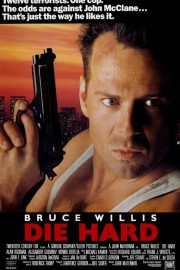Die Hard
Twenty-five years since we were first introduced to John McClane, Bruce Willis’s blue-collar New York cop has become a superhero of sorts, unable to be killed under any circumstances. But when we first saw him flying out to Los Angeles for Christmas, hoping to reunite with his estranged wife (Holly, played by Bonnie Bedelia) at an office party, McClane was someone afraid of flying; upset his wife was using her maiden name; and got along famously with his equally out-of-his-depth limo driver. When terrorists took over his wife’s company’s office building, however, he white-knuckled his way against 12 international terrorists, and won his wife’s love back. Was that too much for a first sentence?
Chalk it up to my excitement to be watching a great “Die Hard” movie again (let alone reviewing one), because this was the only time they made one. John McTiernan, Willis, producer Joel Silver, and writers Jeb Stuart and Steven E. de Souza, cinematographer Jan De Bont, and composer Michael Kamen knew their ways around an action sequence (some still do), but more importantly, they made me care about what was going on. Willis, who was already a TV star thanks to “Moonlighting,” brought a vulnerability to McClane that has all but abandoned the character with the release of “A Good Day to Die Hard,” even though anyone who has seen his performances in thrillers such as “12 Monkeys,” “The Sixth Sense,” “Unbreakable,” “RED,” and, especially, “16 Blocks” (his last terrific starring role) knows that, as an actor, he’s more than capable of it.
Of course, anyone who’s followed action cinema over the past 30 years knows that “Die Hard,” for all its greatness, is one of the films most responsible for the homogenization of the genre over the years. After McTiernan’s instant classic came out, it seemed like every action movie had to be “‘Die Hard’ on a…”, and even though some of them were good (see “Speed,” “Under Siege,” and “The Rock”), others were, well, pretty bad (don’t see “Speed 2: Cruise Control,” “Under Siege 2: Dark Territory,” or even “Die Hard With a Vengeance”). Even after that novelty wore off, action cinema was never the same, and hasn’t quite recovered.
In many ways, the same could be said for McTiernan himself, who made three great action films in a row (with this between “Predator” and “The Hunt for Red October”), but since has not only been embroiled in real-life legal issues, but also seemed to lose the smart edge that made those films successful starting with the Schwarzenegger flop, “Last Action Hero,” and continuing through “Die Hard With a Vengeance,” “The Thomas Crown Affair,” a truly God-awful “Rollerball” remake, and “Basic,” a military thriller that was unnecessarily complicated.
Despite my adoration for “Predator,” and respect for “Red October,” however, “Die Hard” has McTiernan, and actually, all of the people I previously mentioned above, at the very peak of their powers. The movie is smart, funny, and loaded with brilliant action scenes and interesting characters, starting with Willis’s McClane and Alan Rickman’s Hans Gruber, the leader of the terrorists who have taken over the Nakatomi tower for reasons that are unknown to everyone to the audience, making the story that much more fascinating. This is Rickman’s greatest villain role, and still, one of his best roles ever (his 8-film performance as Snape in the “Harry Potter” series is, by far, his best), and it’s easy to see why he became a favorite go-to character actor in Hollywood after this film became a smash. He’s great in the entire film, but he’s especially good during his one, big scene with Willis in the second half of the film when they meet face-to-face. He’s evil incarnate, and he and Willis bounce off each other masterfully, even when they’re just goading one another on the radio. This is the type of character dynamic that’s been largely missing from any of the sequels, but is the heart and soul of what made this film a great, thrilling action masterpiece, even if it’s one of the last ones American cinema has been able to produce.










